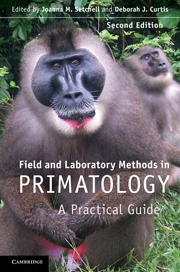Book contents
- Frontmatter
- Contents
- List of contributors
- Foreword by Robert D. Martin
- Introduction
- 1 An ethnoprimatological approach to interactions between human and non-human primates
- 2 Habituating primates: processes, techniques, variables and ethics
- 3 Habitat description and phenology
- 4 Geographical information systems and remote sensing
- 5 Monitoring local weather and climate
- 6 Survey and census methods: population distribution and density
- 7 Trapping primates
- 8 Handling, anaesthesia, health evaluation and biological sampling
- 9 Morphology, morphometrics and taxonomy
- 10 Marking and radio-tracking primates
- 11 Field experiments with non-human primates: a tutorial
- 12 Feeding ecology, frugivory and seed dispersal
- 13 Dietary analysis I: food physics
- 14 Dietary analysis II: food chemistry
- 15 Collecting arthropods and arthropod remains for primate studies
- 16 Recording primate vocalizations
- 17 Photography and video for field researchers
- 18 Chronobiological aspects of primate research
- 19 Thermoregulation and energetics
- 20 Field endocrinology: monitoring hormonal changes in free-ranging primates
- 21 Collection, storage and analysis of non-invasive genetic material in primate biology
- 22 Tips from the bush: an A–Z of suggestions for successful fieldwork
- Index
Foreword by Robert D. Martin
Published online by Cambridge University Press: 05 June 2012
- Frontmatter
- Contents
- List of contributors
- Foreword by Robert D. Martin
- Introduction
- 1 An ethnoprimatological approach to interactions between human and non-human primates
- 2 Habituating primates: processes, techniques, variables and ethics
- 3 Habitat description and phenology
- 4 Geographical information systems and remote sensing
- 5 Monitoring local weather and climate
- 6 Survey and census methods: population distribution and density
- 7 Trapping primates
- 8 Handling, anaesthesia, health evaluation and biological sampling
- 9 Morphology, morphometrics and taxonomy
- 10 Marking and radio-tracking primates
- 11 Field experiments with non-human primates: a tutorial
- 12 Feeding ecology, frugivory and seed dispersal
- 13 Dietary analysis I: food physics
- 14 Dietary analysis II: food chemistry
- 15 Collecting arthropods and arthropod remains for primate studies
- 16 Recording primate vocalizations
- 17 Photography and video for field researchers
- 18 Chronobiological aspects of primate research
- 19 Thermoregulation and energetics
- 20 Field endocrinology: monitoring hormonal changes in free-ranging primates
- 21 Collection, storage and analysis of non-invasive genetic material in primate biology
- 22 Tips from the bush: an A–Z of suggestions for successful fieldwork
- Index
Summary
It is a pleasure and a privilege to contribute to this second edition of Field and Laboratory Methods in Primatology. The first edition was published only eight years ago, in 2003, so it is a clear sign of success that a second edition should follow so rapidly in its wake. I know from personal experience that many primate field workers, particularly those embarking on their maiden study, found the first edition very useful. So this new, updated version will surely be very welcome. Those who appreciated the well-coordinated team effort in the first edition will be pleased to see that the line-up of chapters and authors has remained very much the same. The editors, Joanna Setchell and Deborah Curtis, have once again marshalled the contributions with a sure hand. The original twenty-one chapters have been retained, with minor shifts in authorship here and there. The only substantial change is the addition of a new chapter (Chapter 11) by Zuberbühler & Wittig on field experiments, in recognition of the growing importance of this approach. The editors note that a primary aim of this volume is ‘to encourage fields of research that are currently under-exploited … and to address the (often neglected) broader cultural and legal implications of fieldwork’. It is important here that the editors therefore hope not only to provide a basic practical guide to methods but also to influence the future course of research.
- Type
- Chapter
- Information
- Field and Laboratory Methods in PrimatologyA Practical Guide, pp. xvii - xxxPublisher: Cambridge University PressPrint publication year: 2011

